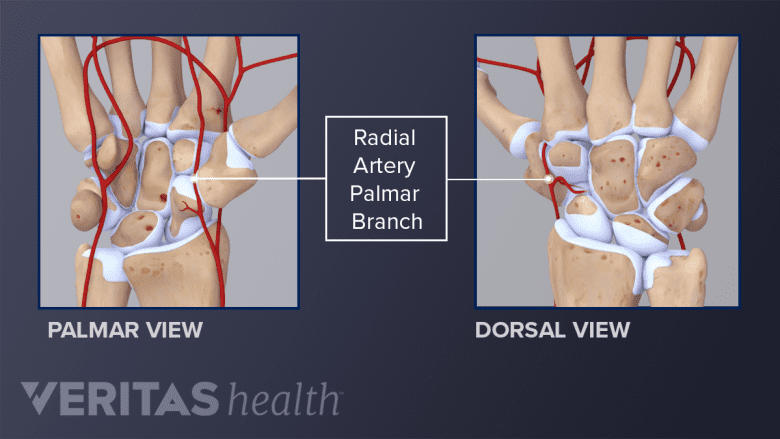In addition to its complex bone structure, the wrist also contains a network of ligaments, tendons, nerves, and blood vessels.
In This Article:
- Guide to Wrist Anatomy
- Soft Tissues of the Wrist
Ligaments and Tendons of the Wrist
Extrinsic ligaments connect carpals to the forearm and hand bones; intrinsic ligaments attach carpals to each other.
The wrist consists of several ligaments and tendons that help provide strength and flexibility to the hand.
Ligaments of the wrist
Ligaments are fibrous bands of tissue that connect one bone to another. The wrist contains a network of ligaments, including:
- Extrinsic ligaments that connect the wrist bones to the long bones of the forearm and the bones of the hand. Extrinsic ligaments include several volar radiocarpal ligaments, volar ulnocarpal ligaments, and dorsal ligaments.
- Intrinsic ligaments that connect the wrist bones to each other. Intrinsic ligaments include several proximal row ligaments, distal row ligaments, and palmar midcarpal ligaments.
Ligament injuries are called sprains. Most wrist sprains involve the scapholunate ligament, an intrinsic ligament which connects the scaphoid and lunate bones.1Andersson JK. Treatment of scapholunate ligament injury: Current concepts. EFORT Open Rev. 2017;2(9):382-393.
Wrist capsule
The radiocarpal joint, where the forearm’s radius bone and the first row of the wrist’s carpal bones meet, is surrounded by the wrist capsule.
- The outer layer of this capsule is fibrous and contains some of the extrinsic ligaments.
- The capsule’s inner layer is made up of a very thin tissue called the synovial membrane.
The synovial membrane produces and holds in a special fluid, called synovial fluid. This fluid helps keep the joint lubricated.
Tendons of the wrist
Tendons are responsible for bending the wrist forward and backward (flexion and extension).
The motions of the hand and wrist are powered by tendons, which connect muscles to bones. The tendons that control the wrist originate from forearm muscles and insert into hand bones. No tendons insert into the carpal bones themselves.
Wrist tendons include the:
- Tendons involved in wrist flexion or the action of bending the wrist forward/inward. These tendons also help in rotating the wrist.
- Tendons involved in wrist extension or the action of bending the wrist backward. These tendons also help move the wrist toward the thumb or the little finger.
- Tendons involved in finger flexion and extension, which pass by the wrist on their way to the fingers.
See Wrist Tendonitis: An Overview
Tendons link the muscle bellies, which provide force, with the joints and bones that get moved, allowing movements such as opening the hand and making a fist. The tendons of the wrist and hand are surrounded by a synovial membrane. Wrist tendon injuries may involve damage to a tendon (lacerations, tendonitis, or tendinosis) or its surrounding synovial membrane (tenosynovitis).
See What Is the Difference Between Tendonitis, Tendinosis, and Tendinopathy?
Blood and Nerve Supply of the Wrist
The radial artery lies close to the skin near the wrist.
Blood vessels and nerves provide nourishment and sensation to the wrist and hand.
Blood vessels of the wrist
Two arteries travel through the wrist and into the hand:
- The radial artery
- The ulnar artery
These arteries are the end branches of the brachial artery, which in turn originates from the axillary artery in the armpit. The radial artery lies close to the skin near the wrist. Its pulse can be felt under the skin below the thumb side of the wrist.
In the wrist, both the radial and ulnar arteries are susceptible to injury by laceration (deep cuts) and may result in significant blood loss.
Nerves of the wrist
Three nerves travel through the wrist and into the hand: the median, ulnar, and radial nerves. These nerves are the end branches of a network of nerves called the brachial plexus located in the shoulder.
Each nerve travels down from the shoulder, providing sensation to different parts of the hand:
- The median nerve enters the wrist through the carpal tunnel and branches into the thumb, index finger, middle finger, and part of the ring finger. When this nerve becomes compressed in the carpal tunnel, it causes carpal tunnel syndrome.
- The ulnar nerve enters the wrist and travels into the ring and little fingers. Compression of this nerve at the elbow causes cubital tunnel syndrome. This nerve also causes “funny bone” shocks when jarred near the elbow. This nerve can also be compressed at the wrist as it passes through Guyon’s canal, which is called handlebar palsy when it happens in bicyclists.
- The radial nerve supplies the forearm muscles that straighten the wrist and fingers. Radial nerve injury in the upper arm can lead to wrist drop or inability to straighten the wrist. It also provides sensation to part of the back of the hand.
Nerve injury in the wrist may occur as a result of trauma from accidents or sports. Nerve injuries may also develop over time from poor workplace ergonomics or prolonged, repetitive motions with the wrist.
The vast majority of wrist injuries are the result of one simple cause: falling on an outstretched hand. This type of fall can cause sprains, strains, dislocations, fractures, nerve injuries and/or damage to blood vessels in the wrist.
- 1 Andersson JK. Treatment of scapholunate ligament injury: Current concepts. EFORT Open Rev. 2017;2(9):382-393.








